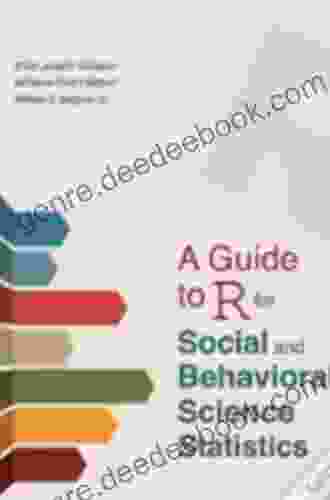A Comprehensive Guide to Statistics for Social and Behavioral Sciences

Statistics play a crucial role in social and behavioral sciences, providing researchers with the tools to collect, analyze, and interpret data in order to gain insights into human behavior and social phenomena. This comprehensive guide aims to provide a thorough overview of statistics for social and behavioral sciences, covering essential concepts, methods, and applications.
4.6 out of 5
| Language | : | English |
| File size | : | 42658 KB |
| Text-to-Speech | : | Enabled |
| Screen Reader | : | Supported |
| Enhanced typesetting | : | Enabled |
| Print length | : | 304 pages |
Essential Statistical Concepts
Before delving into the specifics of statistical methods, it is important to establish a foundation in essential statistical concepts. These concepts include:
- Variables: Characteristics or traits that can take on different values.
- Data: A collection of observations or measurements of variables.
- Scales of measurement: Nominal, ordinal, interval, and ratio scales that determine the level of measurement of variables.
- Population and sample: The entire group of interest and a subset of the population used for research.
- Descriptive statistics: Measures that summarize and describe the distribution of data, such as mean, median, and standard deviation.
- Inferential statistics: Methods used to make inferences from sample data to the population, such as hypothesis testing and confidence intervals.
Quantitative Research Methods
Quantitative research methods involve the collection and analysis of numerical data to test hypotheses and answer research questions. Common quantitative methods include:
- Surveys: Collecting data from a sample using questionnaires or interviews.
- Experiments: Manipulating variables to study their effects on other variables.
- Observational studies: Observing and recording data without manipulating variables.
- Regression analysis: Examining the relationship between dependent and independent variables.
- Factor analysis: Identifying underlying patterns and relationships within data.
Qualitative Research Methods
Qualitative research methods focus on understanding and interpreting non-numerical data to explore social phenomena and human experiences. Common qualitative methods include:
- Interviews: Conducting in-depth conversations with individuals or groups.
- Focus groups: Facilitating group discussions on specific topics.
- Observation: Watching and recording behavior in natural settings.
- Content analysis: Analyzing written or visual data for themes and patterns.
- Narrative analysis: Studying stories and personal accounts to understand experiences.
Mixed Methods Research
Mixed methods research combines quantitative and qualitative methods to provide a more comprehensive understanding of research questions. By combining both approaches, researchers can gain insights from numerical data and in-depth qualitative data.
Data Analysis
Data analysis is the process of cleaning, transforming, and analyzing data to extract meaningful information. Common data analysis techniques include:
- Data cleaning: Removing errors and inconsistencies from data.
- Data transformation: Converting data into a usable format.
- Exploratory data analysis: Identifying patterns and relationships in data.
- Hypothesis testing: Using statistical tests to determine if there is a significant difference between groups or variables.
- Confidence intervals: Estimating the range of values within which the true population parameter likely falls.
Statistical Software
Statistical software is used to automate and simplify data analysis. Common statistical software packages include:
- SPSS: A comprehensive statistical package for data analysis, visualization, and reporting.
- R: A free and open-source programming language for statistical computing and data visualization.
- SAS: A commercial statistical software package for data management, analysis, and reporting.
Statistical Interpretation
Statistical interpretation involves drawing meaningful s from statistical analyses. This includes understanding the meaning of statistical results, considering the limitations of the research, and avoiding common statistical errors.
This guide has provided a comprehensive overview of statistics for social and behavioral sciences, covering essential concepts, methods, and applications. By understanding these concepts and techniques, researchers can effectively collect, analyze, and interpret data to gain insights into human behavior and social phenomena.
4.6 out of 5
| Language | : | English |
| File size | : | 42658 KB |
| Text-to-Speech | : | Enabled |
| Screen Reader | : | Supported |
| Enhanced typesetting | : | Enabled |
| Print length | : | 304 pages |
Do you want to contribute by writing guest posts on this blog?
Please contact us and send us a resume of previous articles that you have written.
 Book
Book Story
Story Paperback
Paperback Magazine
Magazine Newspaper
Newspaper Paragraph
Paragraph Sentence
Sentence Foreword
Foreword Preface
Preface Annotation
Annotation Footnote
Footnote Manuscript
Manuscript Codex
Codex Tome
Tome Bestseller
Bestseller Classics
Classics Library card
Library card Biography
Biography Autobiography
Autobiography Encyclopedia
Encyclopedia Dictionary
Dictionary Narrator
Narrator Resolution
Resolution Librarian
Librarian Borrowing
Borrowing Stacks
Stacks Archives
Archives Research
Research Scholarly
Scholarly Lending
Lending Journals
Journals Rare Books
Rare Books Special Collections
Special Collections Literacy
Literacy Thesis
Thesis Dissertation
Dissertation Awards
Awards Reading List
Reading List Book Club
Book Club Theory
Theory Lecia Cornwall
Lecia Cornwall Charlene A Carruthers
Charlene A Carruthers Catherine Fet
Catherine Fet Stephen K Scroggs
Stephen K Scroggs Javier Auyero
Javier Auyero Fiona West
Fiona West Neil Matheson
Neil Matheson Sublime Studio
Sublime Studio Lillian Sable
Lillian Sable Michael Gray
Michael Gray Caroline Fredrickson
Caroline Fredrickson Richard Bach
Richard Bach Mark Steinberg
Mark Steinberg Sivasailam Thiagarajan
Sivasailam Thiagarajan Nai
Nai Richie Richards
Richie Richards Wynn Anne Rossi
Wynn Anne Rossi Craig Oliver
Craig Oliver Jeri Holland
Jeri Holland Cathryn Fox
Cathryn Fox
Light bulbAdvertise smarter! Our strategic ad space ensures maximum exposure. Reserve your spot today!
 Quincy WardFollow ·16.2k
Quincy WardFollow ·16.2k Avery SimmonsFollow ·3.1k
Avery SimmonsFollow ·3.1k Steve CarterFollow ·15.7k
Steve CarterFollow ·15.7k Amir SimmonsFollow ·15.1k
Amir SimmonsFollow ·15.1k Dustin RichardsonFollow ·8.4k
Dustin RichardsonFollow ·8.4k Noah BlairFollow ·15k
Noah BlairFollow ·15k William PowellFollow ·18.3k
William PowellFollow ·18.3k Terry PratchettFollow ·13.6k
Terry PratchettFollow ·13.6k

 Rodney Parker
Rodney ParkerBasics Beginner Guide To Stage Sound
Start with a good source. The...

 Glenn Hayes
Glenn HayesKiwi in the Realm of Ra: Exploring the Mystical Kiwi...
Origins and...

 John Grisham
John GrishamAdvances In Marine Biology Volume 71
Unveiling the Hidden Wonders...

 Edison Mitchell
Edison MitchellGoodbye Brings Hello: Embracing the Transformative Power...
In the tapestry of life, endings...
4.6 out of 5
| Language | : | English |
| File size | : | 42658 KB |
| Text-to-Speech | : | Enabled |
| Screen Reader | : | Supported |
| Enhanced typesetting | : | Enabled |
| Print length | : | 304 pages |
















